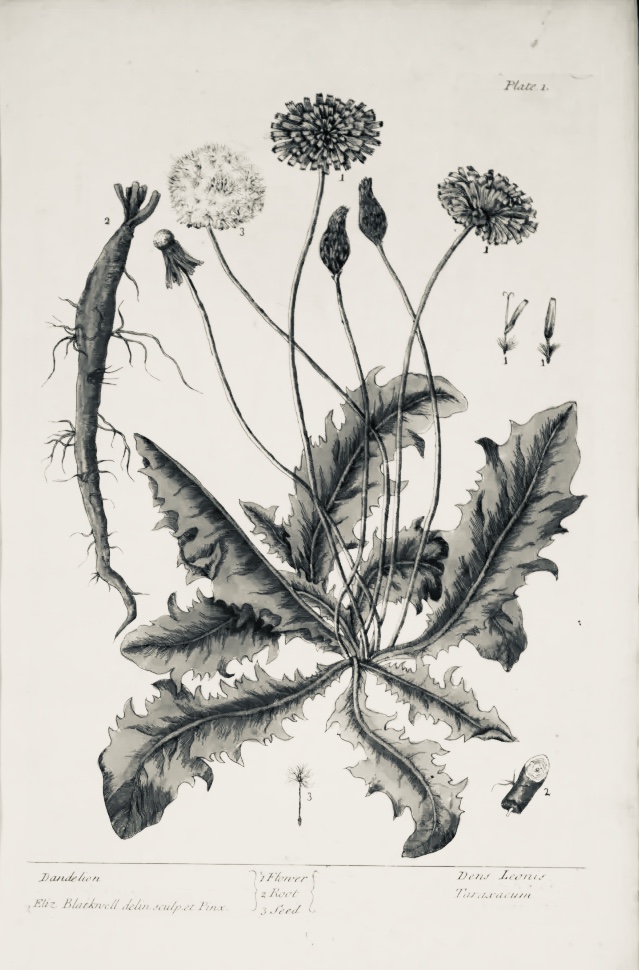
DANDELIONS (Taraxacum)
WILDFLOWER – HERB – MEDICINAL PLANT – WEED
Native to Asia and Europe, the dandelion has been recorded in ancient writings, and Arabian physicians used the plant as medicine in the tenth and eleventh centuries. For centuries, the Chinese and Indians have grown the dandelion to treat liver diseases and digestive problems.
The common dandelion is a perennial, herbaceous (i.e. not “woody”) plant that forms rosettes of leaves with yellow flower clusters rising from the center. The seed head is quite symmetrical and beautiful.
Its name comes from the Latin Dens Leonis;meaning lion’s teeth, describing the plant’s tooth-like leaves. The English changed this phrase to dandelion.
Dandelions were grown alongside vegetables and herbs in home gardens to create remedies from the discomfort of many ailments: baldness, toothaches, fevers, weakness, lethargy, and depression; and as a food commodity. Tonics and teas made from dandelion roots resulted in a gentle, nutritional diuretic that aided digestion and helped the body remove toxins from the liver and bloodstream. In the late spring, dandelion wine was made to drink in the autumn and winter. Ladies drank the sweet and light wine as a digestive. Another common culinary use was roasting dandelion roots for a caffeine free coffee substitute.
Dandelions have been eaten for centuries because the leaves contain numerous vitamins and minerals, including iron, potassium, and calcium. A salad of dandelion leaves is packed with valuable vitamins and minerals.
The dandelion arrived in the Americas at the time of the Mayflower. European settlers used the herb for its many medical advantages. There is a legend that the Pilgrims brought the dandelion seeds to the New World in a golden box and with much ceremony and fanfare, Myles Standish planted them into the virgin soils of eastern North America.
Dandelions are now found throughout North and South America and on every continent except the Arctic, because they tolerate a wide range of conditions.
Their quick spread is due to a few factors. Dandelions are fast growers. It takes as little as 8 weeks for a dandelion to go from seed to seed head. The seed of dandelion are not dormant and can germinate immediately in the same year that they are formed. Long lived, a healthy dandelion can thrive up to 13 years. They are adaptable and they can live in almost any condition except compacted soil. Dandelions are very prolific. They produce 150-200 seeds per flower or 15,000 seeds per plant. Dandelions can grow from the taproot or from new seed spread in the wind.The parachute (pappus)attached to the seed carries it far and wide. There are over 100 different species of dandelions around the world. We most commonly see the common dandelion (Taraxacum officinale) and the red-seeded dandelion (Taraxacum erythrospermum).
Bees, butterflies and other pollinating insects love dandelions. The flower heads consist of tube like florets, each containing nectar and pollen. Although seen as a weed, it can make a good companion plant in the home garden. Its deep roots pull up nutrients for plants with shallower roots, and add nitrogen and minerals to soil. This once-prized plant, which gardeners used to exhibit at county fairs, now holds the title of Public Lawn Enemy No. 1.
Our obsession with lawns dates back to the days when most people were actively involved in agriculture, growing their own food. Lawns were a symbol of wealth, a way to signal that a person could afford to maintain unproductive land. The concept took hold and evolved into its current ideal: a uniform, highly manicured swath of nothing but grass. “It comes down to image. It’s this cultural thing. It means that you take pride of ownership in your lawn.”
In fruit tree orchards and on farms, dandelions bright yellow flowers lures bees away from the fruit and vegetable blossoms. Each plant can be removed by use of a dandelion knife but it must go deep into the ground to remove all of the crown buds.
Today many environmentalists are asking people to leave some dandelion flowers for our native pollinators. In many areas it is the only early food source for bees.
The information in this article comes from National Library of Medicine, Rutgers University, Michigan State University & Smithsonian Museum.
Happy Spring,
James
